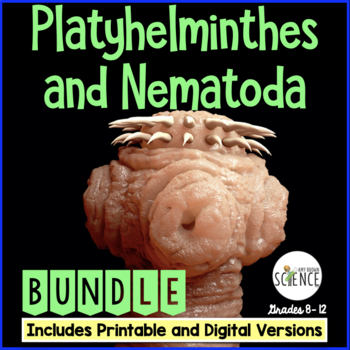Phylum Platyhelminthes and Phylum Nematoda Flatworms and Roundworms Bundle
- Zip
- Google Apps™

Products in this Bundle (10)
showing 1-5 of 10 products
Bonus
Description
This bundle Includes everything you need to teach a unit on Phylum Platyhelminthes and Phylum Nematoda to your life science or biology students. Many of the resources are available in BOTH printable and digital formats. The bundle contains a 60-slide PowerPoint presentation, lecture notes for the teacher, a guided notes outline for the students, Set of 82 task cards, 2 lab activities, 3 homework assignments/study guides, 3 daily quizzes, a crossword puzzle, 3 Jeopardy Review Games, a Guided Reading Activity, and a final unit test.
From the engaging PowerPoint to the final unit test, this bundle contains loads of NO PREP materials that are ready to be used with your students. Many of the resources in this bundle are available in paperless digital formats for use in Google Drive, Google Classroom, Microsoft OneDrive, or similar.
Editable. Printable. Digital.
Complete teacher guides and teacher answer keys are included for each resource.
What is included in this bundle? ( Items marked with ** have both printable and digital versions.)
- PowerPoint and Notes on Platyhelminthes and Nematoda **
- Flatworms and Roundworms Task Cards **
- Homework Assignments for Flatworms and Roundworms: Set of 3 **
- Quiz Set of 3: Flatworms and Roundworms **
- Test: Flatworms and Roundworms **
- Lab: Flatworms and Roundworm Slide Lab
- Lab: Observing Live Planaria
- Flatworm and Roundworm Jeopardy Review Games Set of 3
- Flatworm and Roundworm Crossword Puzzle
- Parasitic Worms Guided Reading Activity **
Topics covered are:
- Introduction to the Worms: Three phyla of worms (Platyhelminthes, Nematoda, and Annelida) are introduced.
- Why worms are more advanced than poriferans and cnidarians: Body shape and symmetry, bilateral symmetry, anterior, posterior, dorsal, ventral, and possession of three germ layers.
- Introduction to the Phylum Platyhelminthes, definitions of free-living, endoparasite and ectoparasite.
- Structure of the flatworm body: Three germ layers, acoelomate, the consequence of no coelom, digestive system with one opening, cephalization, differences in body structures between free-living and parasitic worms.
- Classification of Flatworms: Class Turbellaria, Class Trematoda, Class Monogenea, and Class Cestoda.
- Class Turbellaria, the Planaria: Introduction, movement of planarians, students will label a diagram to learn the external features of the planarian body.
- Planarian Digestive System: Students will label a drawing of the planarian digestive system, pharynx, gastrovascular cavity, method of food-getting, digestion, and absorption by the body.
- Planarian Excretory System: Students will label a drawing of the planarian excretory system, excretory tubules, pores, flame cells, cilia.
- Planarian Nervous System: Students will label a drawing of the planarian nervous system, eyespots, ganglia, longitudinal nerves, transverse nerves.
- Planarian Reproductive System: Asexual by fission and regeneration, sexual reproduction, hermaphroditic.
- Characteristics of Parasitic Worms: Definition of parasite, host, endoparasite, ectoparasite, degeneration. Hooks, suckers, tegument.
- Class Trematoda – Parasitic Flukes: Characteristics of flukes, life cycle of the fluke, differences between primary host and intermediate host.
- Medical conditions caused by flukes: Schistosomiasis, Swimmer’s Itch.
- Class Cestoda – Tapeworms: Characteristics of tapeworms, body structure of tapeworms, scolex, neck, proglottids, hooks and suckers. Life cycle of the tapeworm.
- Phylum Nematoda: Introduction to nematodes, characteristics of nematodes, pseudocoelomates, tube-within-a-tube digestive system.
- Characteristics and life cycle information on the following roundworms: Ascaris, Hookworms, Trichina Worms, Pinworms, Filarial Worms.
- Ways to control parasitic worm infestations.
Related Resources Include:
Invertebrate Phyla Card Sort Game
Platyhelminthes and Nematoda Warm Ups and Bell Ringers
For updates about sales and new products, please follow my store:
I would love to have you follow me at these locations as well:
My Blog: Amy Brown Science.com
Instagram: @AmyBrownScience





